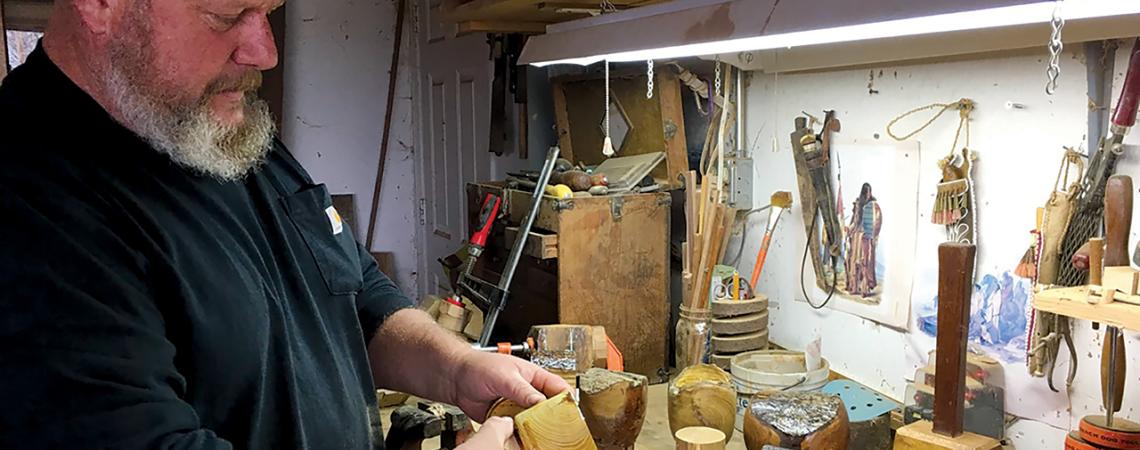Ken Duerksen puts the finishing touches on a lidded box at his garage worktable. (Photo by Karen Holcomb)
Ken Duerksen envisages art amid decay. He rescues cast-off wood pieces from burn piles and salvage yards and transforms them into beautiful objects, including organic sculpture, tableware, furniture, chopsticks, and bento boxes.
Duerksen — a Butler Rural Electric Cooperative member — uses what he describes as “gem-quality” reclaimed black cherry, Osage orange, black walnut, and other native species. “All my wood is salvaged,” he says. “Sawmills in the vicinity will let me pick through their burn piles. That’s where some real jewels are found. So basically, I use wood that is not easily marketable,” including dozens of ash trees on his property that were devastated by the emerald ash borer.
“The process of decomposition sometimes makes things really beautiful,” Duerksen says, explaining that the unique knotholes, graining, and coloration found on diseased wood enhance its aesthetic quality.
Learning from his dad
Duerksen lives in Reilly Township, on the outskirts of Oxford, home to Miami University. A professional archaeologist who consults on construction projects for a living, Duerksen learned the finer points of woodworking from his father, an English professor at Miami. He grew up watching his dad dig trenches, pour concrete, build additions to their home, and create a different wooden Christmas ornament each year for family members. The younger Duerksen continues the holiday tradition to this day.
“I’ve been making things out of wood my whole life,” says Duerksen, who designed and built toys as a child. “My dad always let me use his power tools. When I was 10, I would use his old death-trap table saw.”
Use what the wood presents
Duerksen loves the organic beauty of wood in its raw state. He leaves the natural edge on his rice bowls and serving trays. He uses the graining to enhance the aesthetics, as well as the functionality, of each piece. Many pieces contain other organic elements. Duerksen’s “Neolithic nutcracker,” for example, includes a space for nuts and two openings that securely hold a pair of rocks to crack open the nuts.
His archaeology background also comes into play. Duerksen’s “effigy bowls,” inspired by Native American feast bowls, feature the likeness of an animal, such as a bear or bird, carved on a top edge. He also uses archeological motifssimilar to those discovered on artifacts from the mound-building Adena tribe native to southern Ohio.
Duerksen creates the pieces in an attached garage he converted to a workshop. He utilizes assorted hand tools and a lathe he built 20 years ago from an old cast-off motor. Wood pieces are stacked in piles or lean against the walls, sawdust covers the floor, and a friendly gray cat named Bonabo wanders in and out.
Asian-influenced flair
Duerksen sells his pieces on the internet, at art fairs, and in a shop called Local Yokel Mercantile in the Cincinnati area. His best-selling products include rice bowls fitted with chopsticks, natural-edge trays, and individual chopsticks with a unique holder that he invented.
“I just love chopsticks,” Duerksen says. “I like Asian aesthetics.”
His other Asian pieces include sushi trays, which double as cheese platters, and bento boxes — Japanese-style lunch trays with compartments for different foods. The oil finish is nontoxic and safe for food use, but customers often use these items as wall hangings because of their natural beauty.
Over the decades, Duerksen has gained an encyclopedic knowledge of the aesthetics and functionality of wood, and he skillfully marries the two in each object he carves. He can look at a log and know not only the species, but whether the tree was cut in summer or winter. (The bark stays firmly attached if the tree was cut during summer. The bark separates if the tree was cut during winter.)
His attraction to his preferred medium is simple.
“It’s everywhere,” Duerksen says. “It’s beautiful. I understand it. I know how the grain works. I love the evocative grains you can get with a knot or a burl. It’s a random, organic beauty.”
Karen Holcomb is a freelance writer from Butler County and a member of Butler Rural Electric Cooperative.









